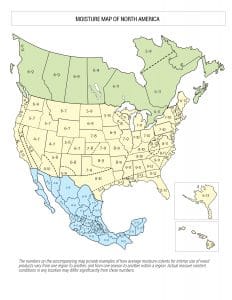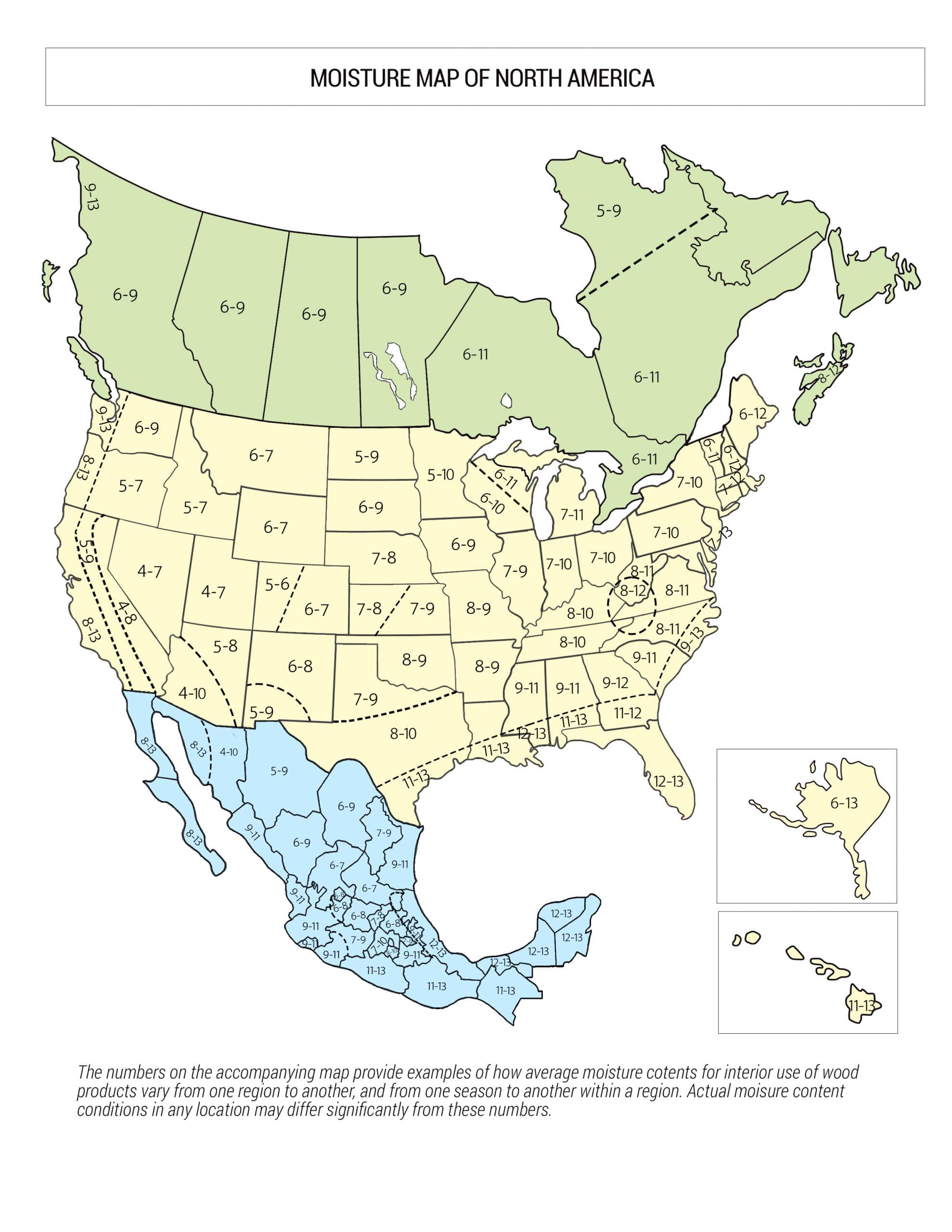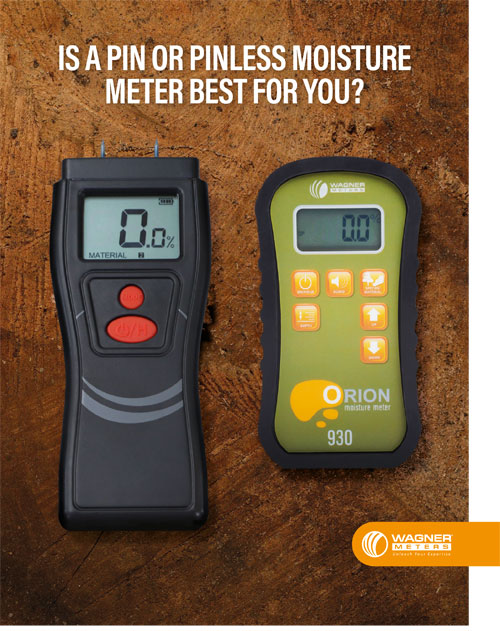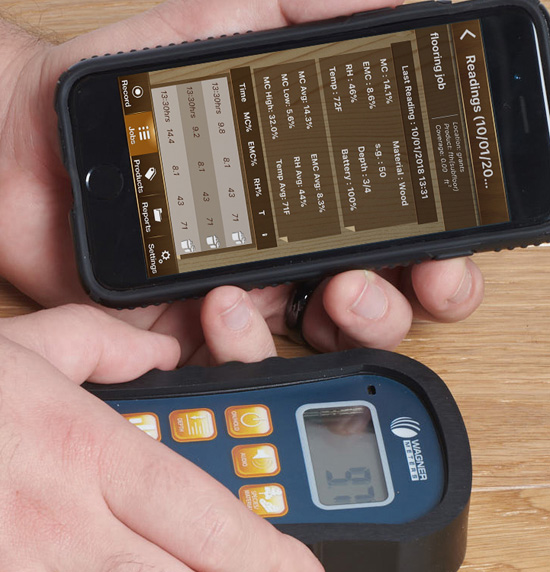Understanding Moisture Content Is Important for Woodturners
Successful woodturning, just like all woodworking, requires careful management of wood moisture content. Moisture content is an important factor in how wood works and in the durability and lasting beauty of the finished product.
Understanding Moisture Content
 All wood contains moisture. Wood is a hygroscopic material, which means it easily absorbs or releases moisture. The moisture in the surrounding air determines the moisture content (MC) of wood.
All wood contains moisture. Wood is a hygroscopic material, which means it easily absorbs or releases moisture. The moisture in the surrounding air determines the moisture content (MC) of wood.
Relative humidity (RH) measures moisture in the air. It represents how much water the air holds compared to how much it could hold at a given temperature and pressure.
As RH increases, wood absorbs moisture from the air, which causes it to expand. As RH decreases, wood releases moisture into the air, which causes it to shrink.
MC is the ratio of the weight of water in a piece of wood compared to the weight of the wood without water. The formula is:
MC = (weight of water / weight of dry wood) x 100
For example, a 10 lb. block of wood (as measured once it’s dry), containing 1 lb. of water has an MC of:
(1 / (10 – 1)) x 100 = 11.1 %
The Importance of Controlling MC
Wood expands and contracts as its MC changes. So if MC is allowed to drop significantly after a piece has been turned, the wood can shrink, crack or warp. Warping occurs because wood shrinks more in the direction of the grain than it does across the grain, or because the wood is unevenly dried.
This means MC must be kept steady within about 2% through the process of making wood products and all the way through when the product is in service.
RH and Equilibrium Moisture Content
As we saw before, MC is determined by the relative humidity of the surrounding air. As RH increases, wood absorbs moisture. As RH decreases, wood releases moisture to the air. When the RH is in balance with MC, the exchange of moisture stops. This is called the equilibrium point, and the MC of the wood at this point is called the equilibrium moisture content (EMC).
To avoid problems with expansion and contraction, keep the wood at an EMC close to the value where the product will be used.
For most indoor spaces in North America, the average RH is 30% to 50%, which corresponds to an EMC of 6% to 9%.
Moisture Problems in Wood Turning
Improper MC can cause problems when you’re turning the wood. If the MC is too high, the wood fibers will be weak, and the wood will not turn smoothly. If MC is too low, the wood can crack or chip.
Uneven drying can also cause problems. Wood that was dried too quickly can have a higher MC in the center than on the surface. This causes the surface to shrink more than the center and creates stress inside the wood. When the wood is turned, the stress is released, and the wood warps.
Wood can also dry unevenly because moisture is released from the end-grain faster than it is along the grain.
Because wood shrinks across the grain more than it does along the grain, too much shrinkage after the wood is turned can cause the piece to warp.
How Twice Turning Can Help Control Shrinkage
Twice turning reduces blank drying time, ensures smooth turning, and prevents cracks and warping after the piece is turned.
As the name implies, it’s a two-step process. First, a green blank is turned to remove most of the waste material. Then the piece is allowed additional time to dry. With most of the waste material removed, the piece will dry much faster than the whole blank would.
As the wood dries, the piece will naturally distort. Once the wood reaches the correct MC, the final turning removes the remaining waste material and produces the final shape. With the correct MC, the piece will not shrink or distort after the final turning.
Controlling Moisture Content
Moisture control begins long before you start turning. There are several sources of wood for turning, and MC can vary widely depending on which type you choose.


Many woodturners like to start with green wood. Green wood is freshly sawn and has not been dried. The nice thing about green wood is that you can choose a piece with more character than a piece of kiln-dried lumber, and it can be inexpensive or free.
Kiln drying uses heat and air circulation to speed up the drying process. Kiln-dried wood is dried to an MC of about 8%, which makes it ready for turning. The drawback is that it’s relatively expensive.
Air-dried wood is less expensive than kiln-dried, but it’s usually only dried to about 10% to 18% MC. You’ll need to dry this wood further before final turning.
Drying Wood
If you’re using wood that isn’t dried to the proper 6% to 9% MC, you’ll need to dry it yourself. There are several ways to do this. First, you can air-dry it by keeping it in an enclosed space that’s conditioned 30% to 50% RH. Drying this way can take many months, but it’s inexpensive and it ensures slow, even drying.
You can also kiln-dry it by using a home-made kiln. If you have a small enclosed space, you can provide heat with regular incandescent light bulbs. Some people have had success with drying wood with a microwave oven. However, there can be problems if it is not done correctly or done too fast.
The end grain dries faster than the rest of the wood. You can ensure more even drying by protecting the end grain with a coat of a product like Anchorseal.

Free Download – Is a Pin or Pinless Moisture Meter Best For You?
Using a Scale to Determine When Wood Is Dry
As wood dries and approaches its EMC, drying slows and eventually stops. You can tell when this happens by weighing the wood. You need to do this in your controlled space that you keep to 30% to 50% RH.
With a precise digital scale, weigh the wood every few days and record the weight until it stops losing weight. Once the wood has stabilized, it’s at the correct MC and ready to be turned.
Using a Scale to Precisely Measure MC
You can also measure the exact MC by using a scale. This is a more complicated and tedious process, and it requires a very precise scale. It also requires an oven for drying the wood. Wood releases toxic chemicals as it’s drying, so the oven must be dedicated strictly to this purpose.
First, cut a small block about 1” on the side from the wood you want to measure. Weigh the block to within a tenth of an ounce and record it. This is called the “initial weight.”
Next, dry the block in an oven at about 210 to 220 degrees Fahrenheit. You’ll need to dry it for about 24 hours. Then weigh the wood every few hours and record the weight. When the wood stops losing weight, it’s dry.
Weigh the block and record the weight. This is the “oven-dry weight.” Then use the two weights to calculate MC:
MC = ((initial weight – oven dry weight) x 100 ) / oven-dry weight
Measuring MC with a Moisture Meter
 Measuring MC with a scale is time-consuming and tedious. Moisture meters can make it faster and more convenient.
Measuring MC with a scale is time-consuming and tedious. Moisture meters can make it faster and more convenient.
There are two types of moisture meters available: pin-type meters and pinless meters.
Pin-type meters use the electrical resistance of moisture in the wood to measure MC. The meter has two metal pins that you push into the wood to the desired depth. The resistance is measured between the pins. The lower the resistance, the higher the MC.
Pin-type meters are sensitive to temperature, so they usually come with a temperature correction chart. They’re also sensitive to the chemical makeup of the wood species, so a species setting is usually provided.
The orientation of the wood grain also affects the reading, so you need to drive the pins at the correct orientation.
Pinless meters send an electromagnetic signal through the wood that measures the wood’s dielectric properties. To take a reading, you place the meter on a flat surface of the wood. The reading is available in seconds. There are no pins to mar the surface of the wood. There’s no time wasted hammering the pins into the wood, so a pinless meter can be much faster to use.
Pinless meters are sensitive to wood density and come with a species setting to compensate. To measure at different depths, use a good pinless meter that has a selectable depth setting. Grain orientation does not affect the readings.
Wood moisture meters are much faster, easier, and reliable than using a scale to measure MC.
Pinless meters have these advantages over pin-type meters:
- They don’t mar the wood surface
- They don’t require orienting and driving pins
- There are no pins to bend or break
- They are unaffected by temperature and grain orientation
- They are faster and easier to use
Eric is excited to fight the moisture problems that cause billions of dollars of waste in the United States and the rest of the world. It also helps that he enjoys spending his free time woodworking, and he knows his projects will be free of moisture issues.
Related Posts via Taxonomies
Last updated on January 5th, 2023




Very helpful! I am still looking for more data around executing the process and getting results using meters.
Very informative many thanks